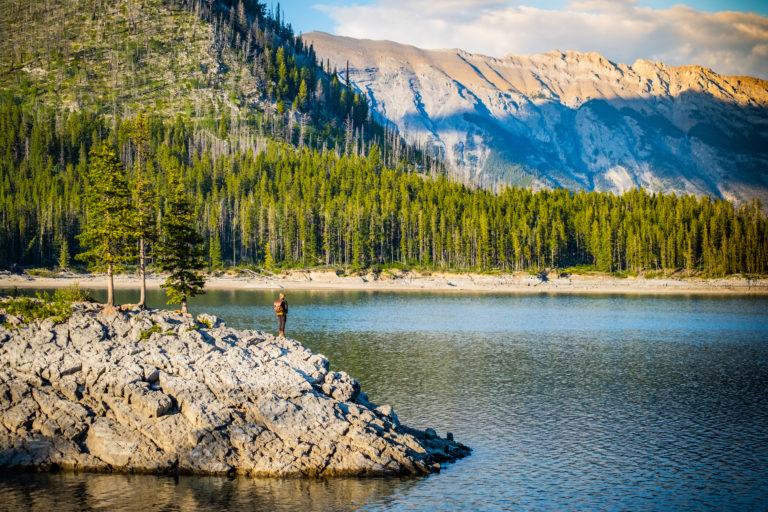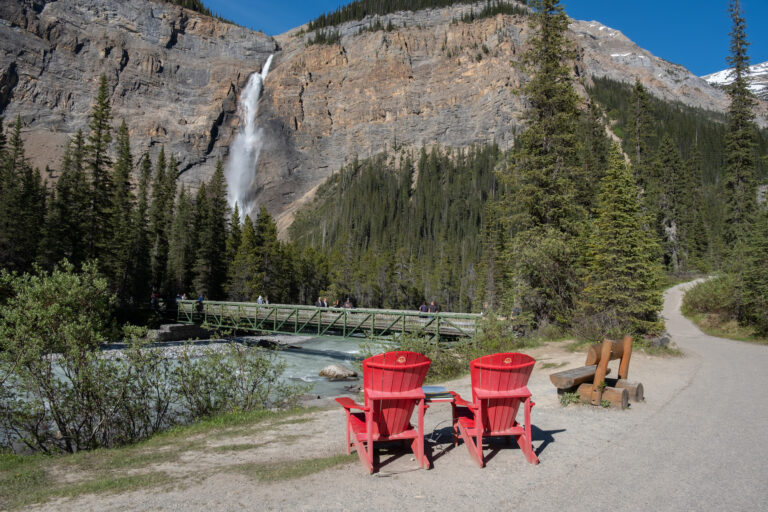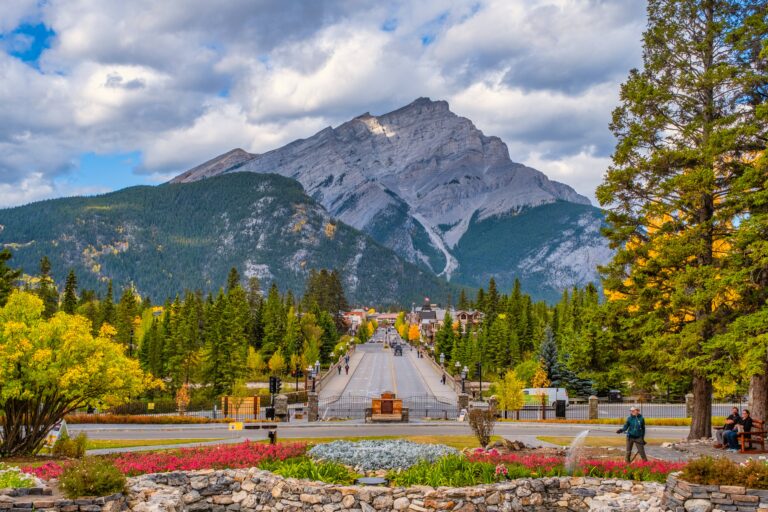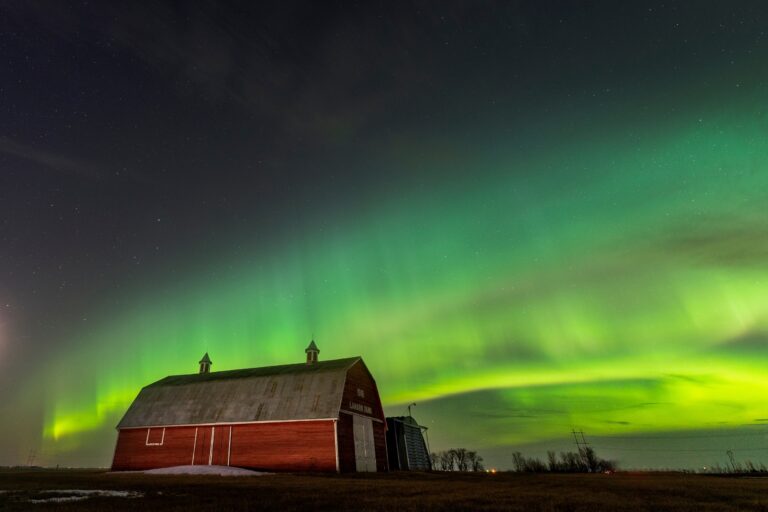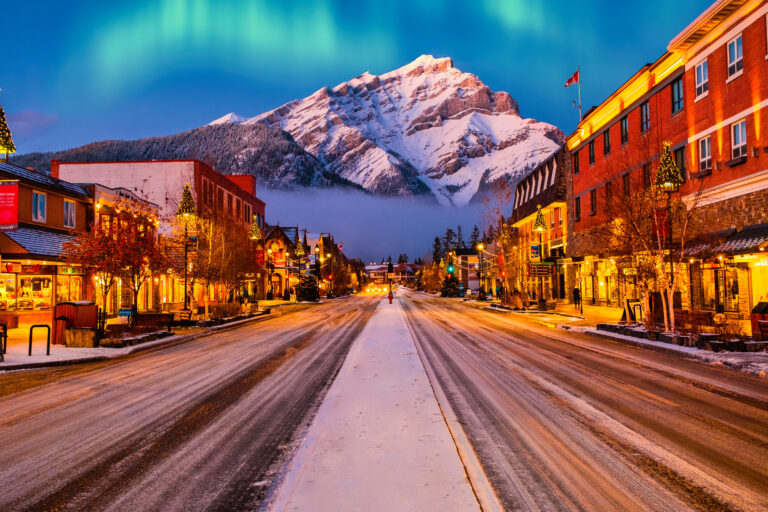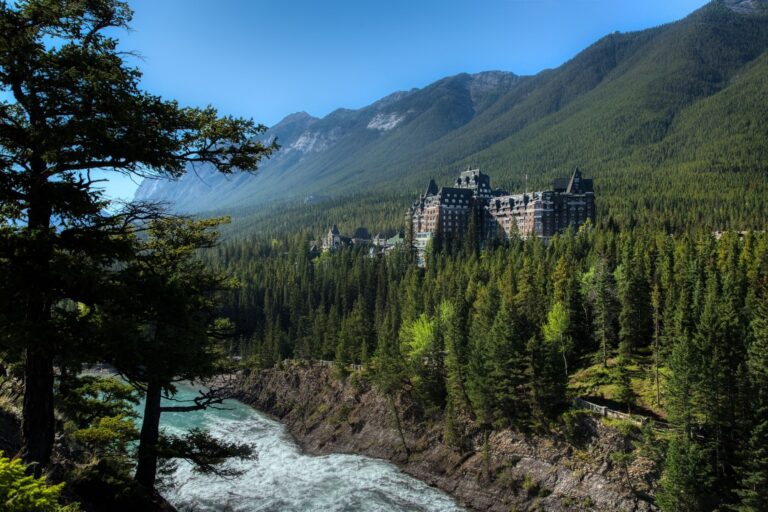A Complete Guide to the Wildlife in Banff
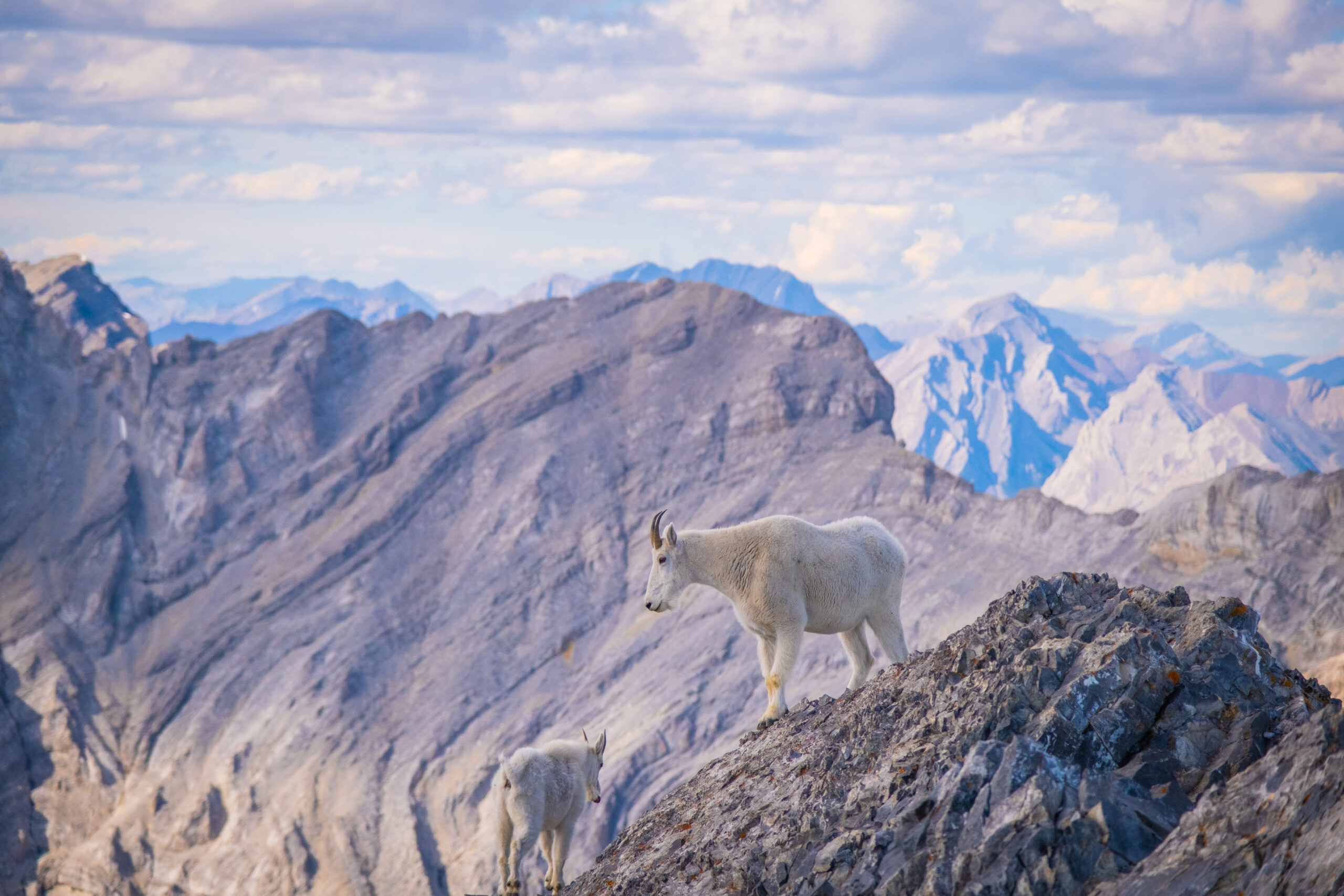
The Canadian Rockies are home to an incredible range of wildlife – from the feisty pika to symbolic beavers to commanding predators like bears, wolves, and cougars. Over 50 species of mammals roam the mountains’ varied habitats, 300 species of birds cross the skies, and 19 types of fish navigate the waterways. In Banff and beyond, scenes from nature documentaries could be waiting around any corner.
Catching a glimpse of Rocky’s wildlife is a treasured highlight of any trip to Canada’s mountain parks, but some creatures are more elusive than others. Let us introduce you to the wild locals you could meet in the mountains.
Safe & Respectful Wildlife Encounters
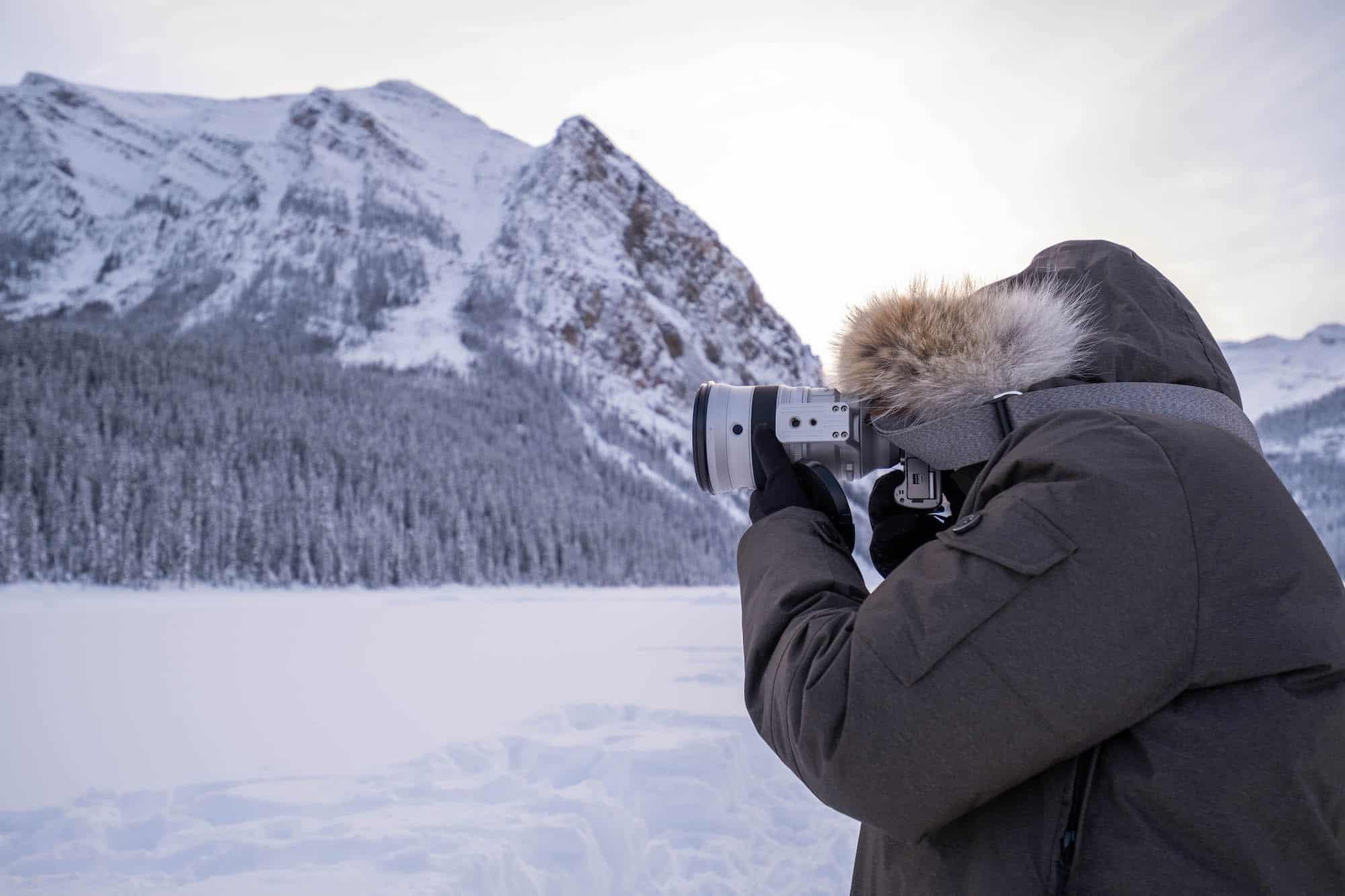
Spotting wildlife is a thrilling experience. But don’t let excitement overrule common sense. Respectful and responsible behaviour around animals helps ensure their survival and your own safety. Be sure to follow these rules to protect our wild neighbours:
- Keep your distance: Wildlife are happiest when left to their business, so leave them enough space to feel comfortable. Parks Canada recommends staying at least 30m (or 3 bus lengths) away from elk and moose and at least 100m (10 buses) away from carnivores like bears or coyotes. Instead of attempting a selfie, bring binoculars or a telephoto lens!
- Never feed wildlife: This endangers wildlife by habituating them to human areas. Feeding wildlife is also illegal in the National Parks, and you could be charged a hefty fine ($25,000!) if you offer food directly, leave food out, or litter. When camping or picnicking in the Rockies, all food-related items and scented products must be stored in vehicles or wildlife-proof lockers. Garbage must be packed out or disposed of in designated bins.
- Keep dogs leashed: Off-leashed dogs are perceived as threatening wildlife and can unwittingly provoke attacks. Keeping your dog on a leash and under control protects them and the mountain creatures.
- Drive slowly and remain in your vehicle: As tempting as it can be to stop and ogle animals on the side of the road, staying in your vehicle and driving by slowly is a much safer option for everyone and prevents ‘bear jams.’ Always respect speed limits in the mountains – driving at posted speeds improves animal safety and makes it easier to spot them!
- Be aware of your surroundings to avoid surprising wildlife: While on trails, register any signs of wildlife and make noise so your presence is known. Many hikers favour regular calls of ‘hey bear’ when traveling through dense or noisy areas like creeks. Hiking in a group is best, with groups of 4 or more optimal while in bear country.
- Carry bear spray: Much like seatbelts, this is protection you should always have while hiking in the Canadian Rockies but hope to never use. Read more about proper bear safety in Western Canada.
- Stay on designated trails and respect closures. Park authorities may restrict access to areas periodically to reduce stress on animals in key times like breeding and feeding seasons.
Guide to Wildlife of the Canadian Rockies
Bears
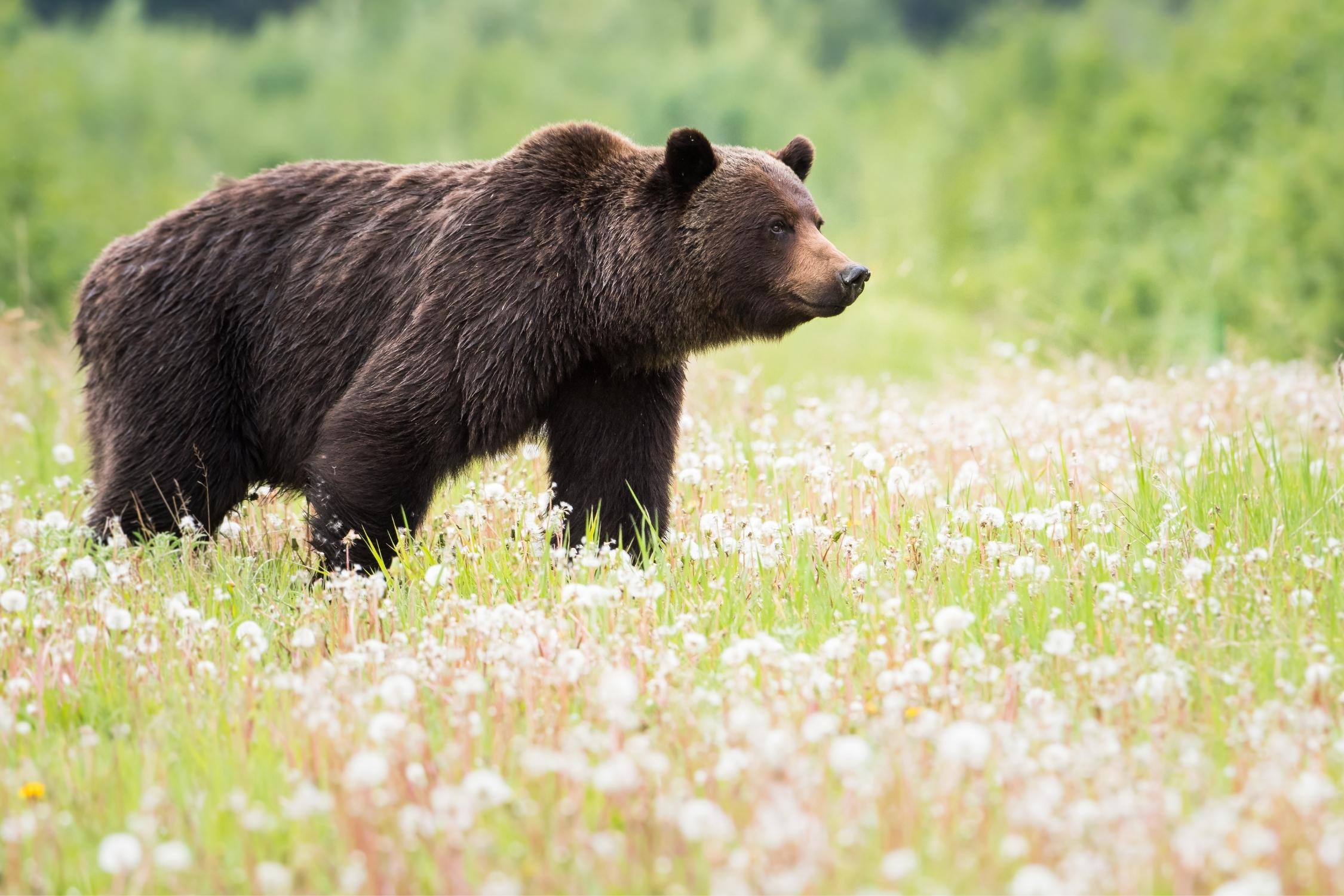
Perhaps the most famous Rockies residents, bears are enchanting creatures, and sightings are some of the most sought-after mountain experiences. While their appearance and behaviours can seem cuddly and personable, bears should be treated with the respect they deserve.
Two species roam the Rockies: black and grizzly bears. Despite their names, colour alone isn’t a reliable way to tell these two apart. Instead, you’ll need to pay attention to their physiology and look for key features:
| Black Bear | Grizzly Bear |
| – No shoulder hump; rump higher than shoulders – Generally smaller size – Short claws for tree climbing | – Shoulder hump; rump lower than shoulders – Generally larger size – Long claws for digging |
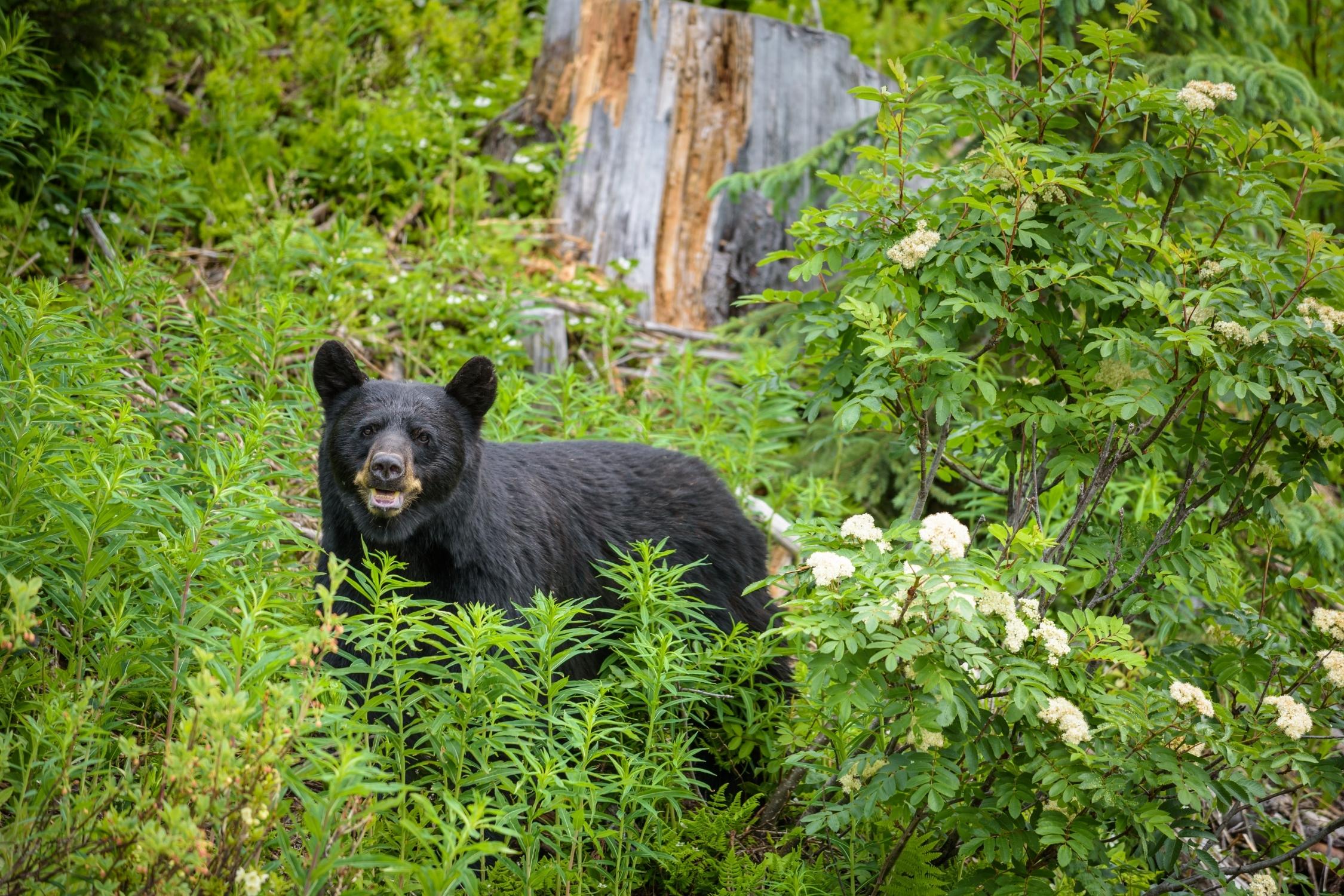
Bears will roam incredible distances from the spring through fall to consume enough food to sleep through the long winter months. With some of the keenest noses in the animal kingdom, bears can pick up scents from many kilometers away. Many food storage and waste disposal systems in the parks have been designed to outwit and outmaneuver these highly intelligent creatures.
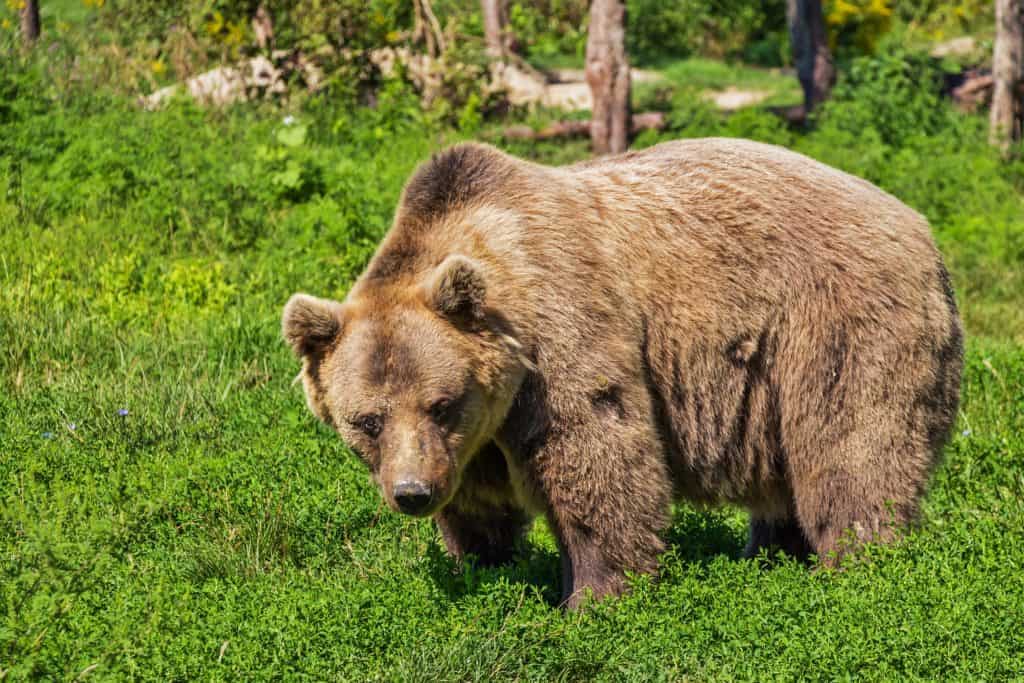
The most legendary bear in Banff National Park is known as ‘The Boss’, a 700-lb male grizzly who has fathered most of the park’s cubs and survived not one, but two train collisions! He’s just one testament to the resiliency of these incredible creatures.
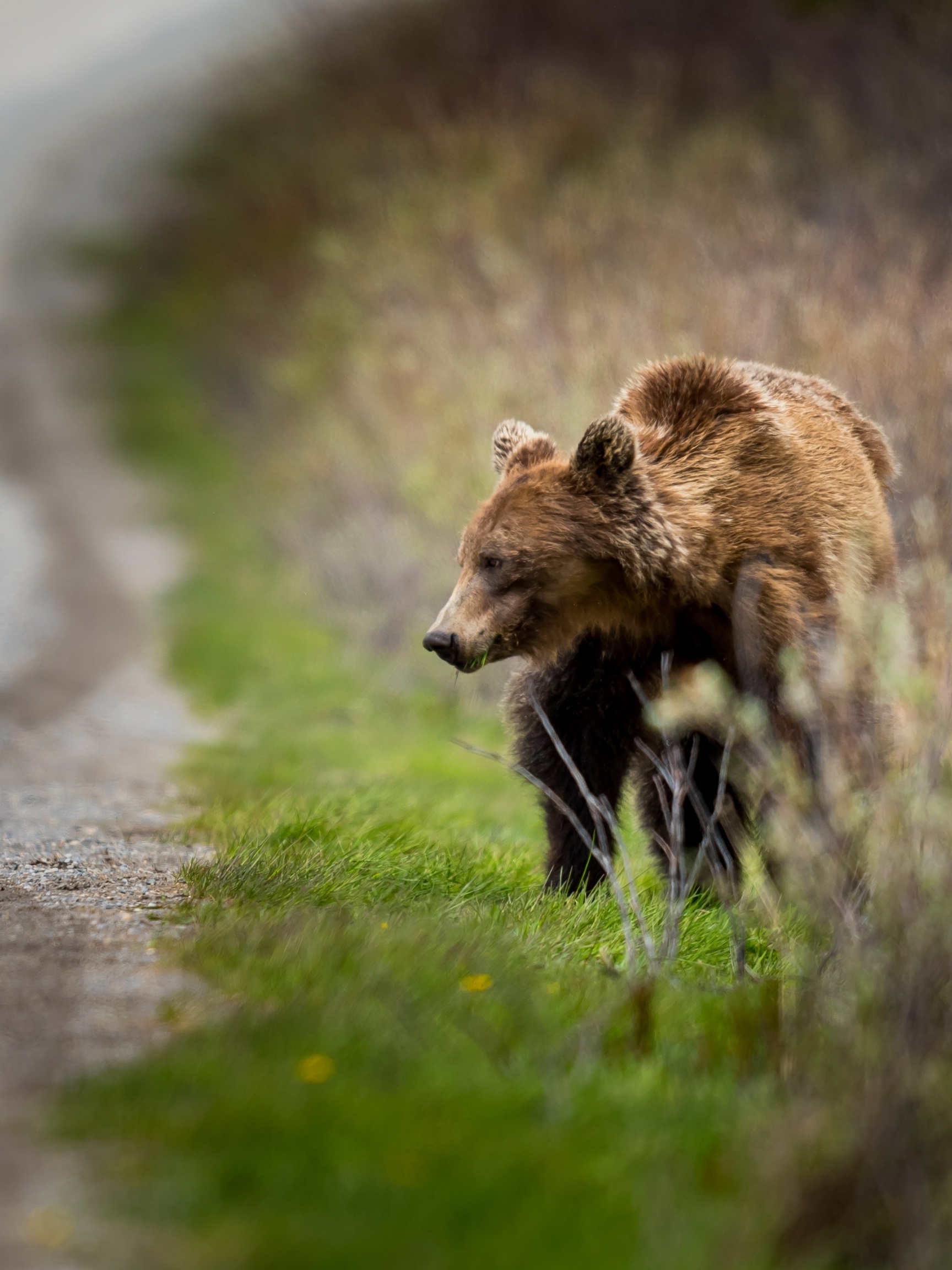
Where Might You See a Bear?
Bears love to snack on berries and roadside vegetation, so sightings while driving are possible, particularly along the Bow Valley Parkway, the Lake Minnewanka Loop, and the Icefields Parkway in Banff, as well as the Spray Lakes Road and Highwood Pass in Kananaskis. There are also regular sightings around Sunshine Meadows and the Lake Louise Summer Gondola.
Since bears mostly slumber through the winter, the best sighting chances fall between April and November. Spring and summer are the best seasons to see bears foraging in the mountain valleys and alpine meadows. Those set on seeing a bear while in the Rockies should head to Kicking Horse Mountain Resort in Golden, BC, where a refuge provides a home for the orphan, Boo.
Elk
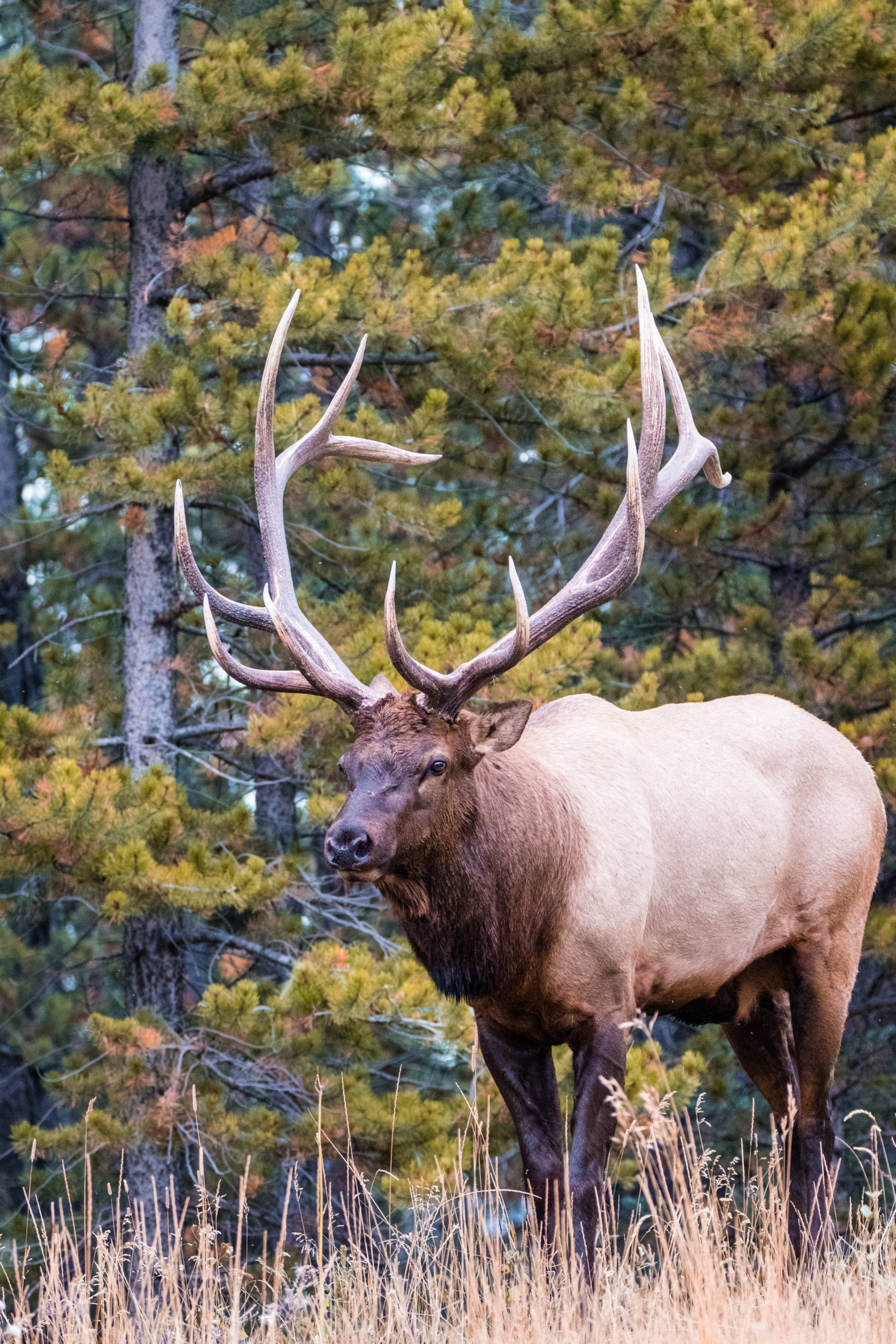
You will likely encounter these regal ungulates, which are one of the most common mammals in the Rockies. Also called ‘wapiti’ for their white rumps, elk are much larger than related deer. Don’t be fooled by their docile demeanor elk are the most dangerous creatures in the mountain parks. Every year there are numerous incidents and injuries to those who find themselves on the wrong side of their impressive antlers.
Elk are especially confrontational in the spring (May – June), when mothers fiercely protect their new calves and in the fall mating season (September – October) when bull elk display their dominance with a high-pitched bugling and charging. The showdowns between bull elk are a fascinating spectacle, but best observed from a safe distance.
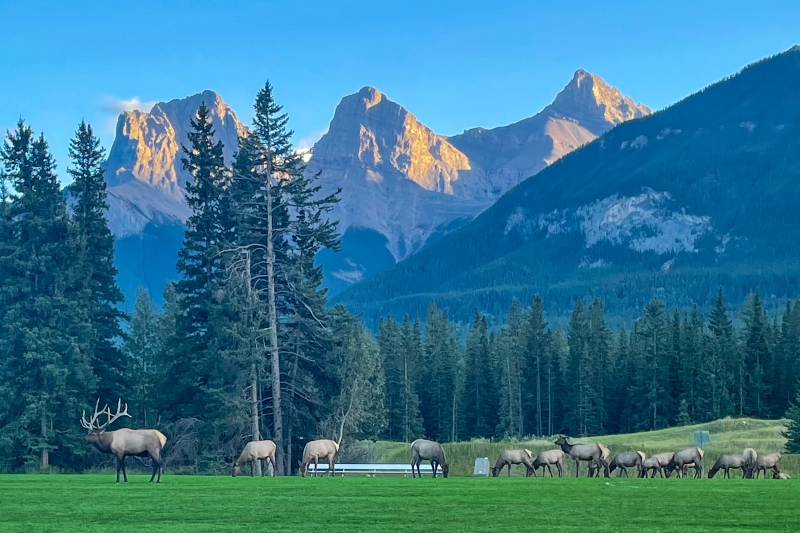
Where Might I See Elk?
Elk are active all year round and frequently wander around Banff, Canmore, and Jasper, where the bustle of human activity helps to ward off their predators. Elk can often be seen grazing by the highways and large clearings like campgrounds, recreation areas, and golf courses. Local herds are regularly seen at the Banff Springs Golf Course, Vermillion Lakes Drive, and Larch Island in Canmore.
Deer
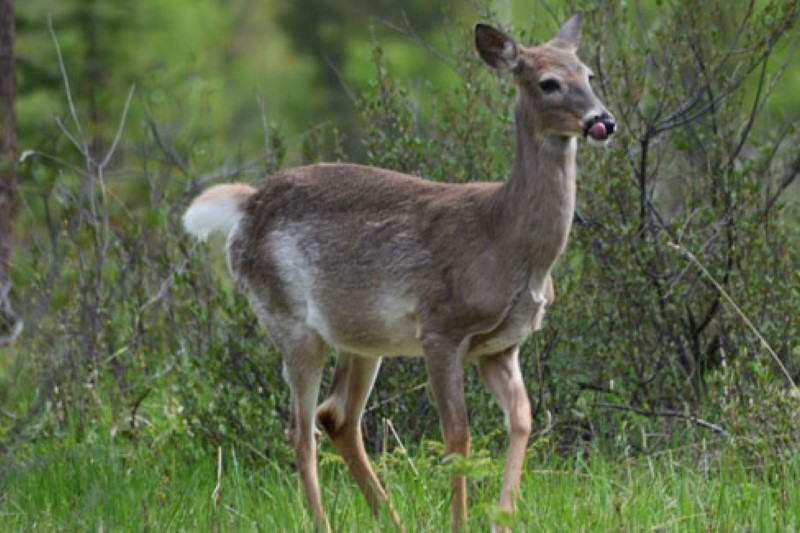
Like elk, deer sightings are all but guaranteed if you spend enough time in the Rockies. Two species reside abound and their names provide an easy guide to differentiation. White tailed deer boast this unique feature while mule deer have large ears (much like a mule) and black-tipped tail. Deer very often graze along roadways, but often blend into the shrubs and brush. Keep a keen eye out.
Bighorn Sheep
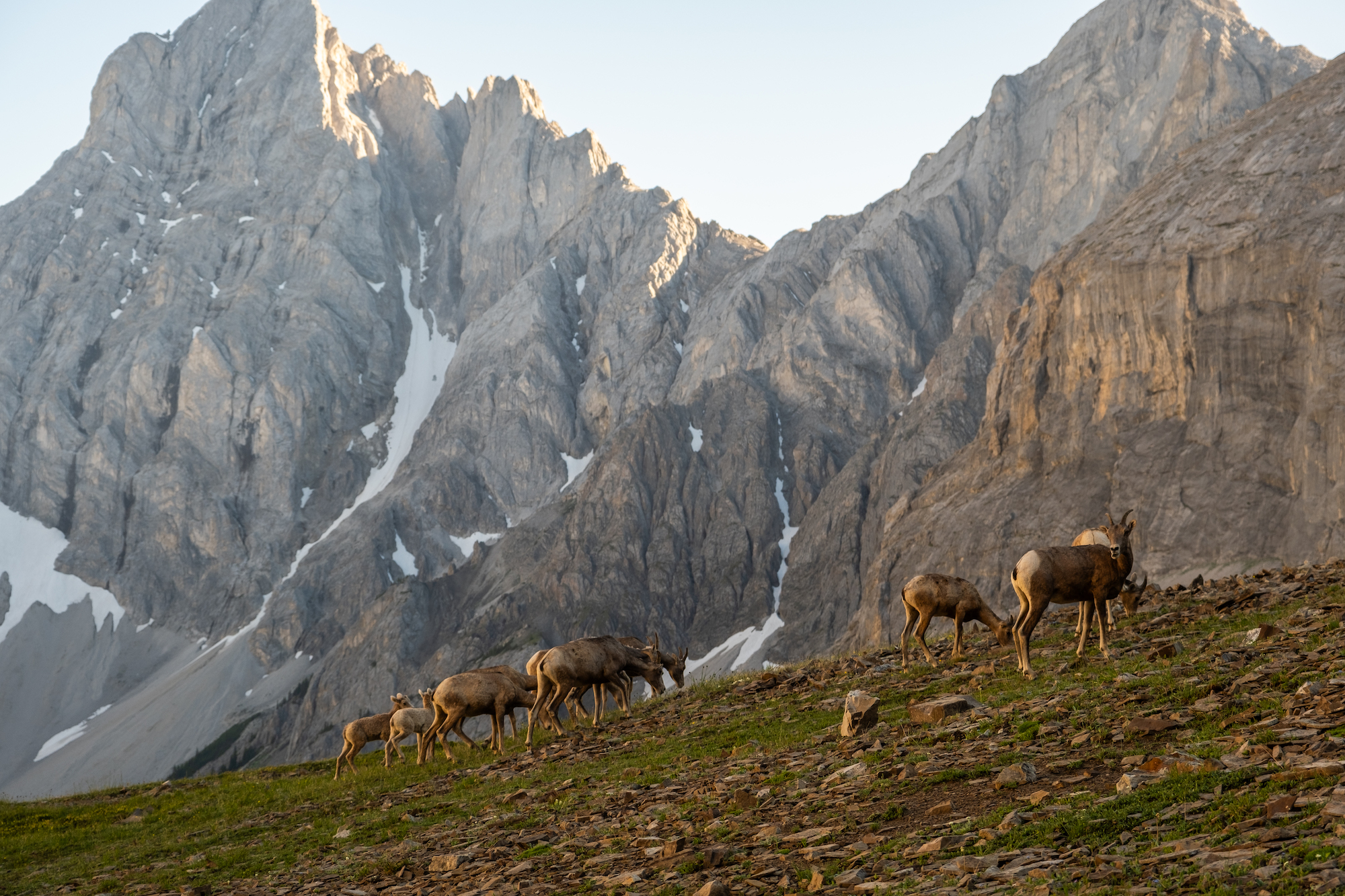
The official mammal of Alberta, bighorn sheep thrive in the Rockies and you’re likely to encounter one or more herds. While all adult sheep are adorned with horns, it’s the rams who sport the iconic curved horns that they crash together in a show of dominance during the fall mating season.
Where Might I See Bighorn Sheep?
Bighorn sheep love rocky ledges almost as much as they enjoy licking roadway minerals. In the colder months, they often congregate on winding mountain drives like the Minnewanka Loop and Mt. Norquay Road in Banff, as well as Highwood Pass in Kananaskis, and the road that leads up to Spray Lakes from Canmore between Ha Ling Peak and the East End of Rundle. Bighorn sheep are also known to roam the slopes at the top of Sulphur Mountain during the warmer months.
Mountain Goat
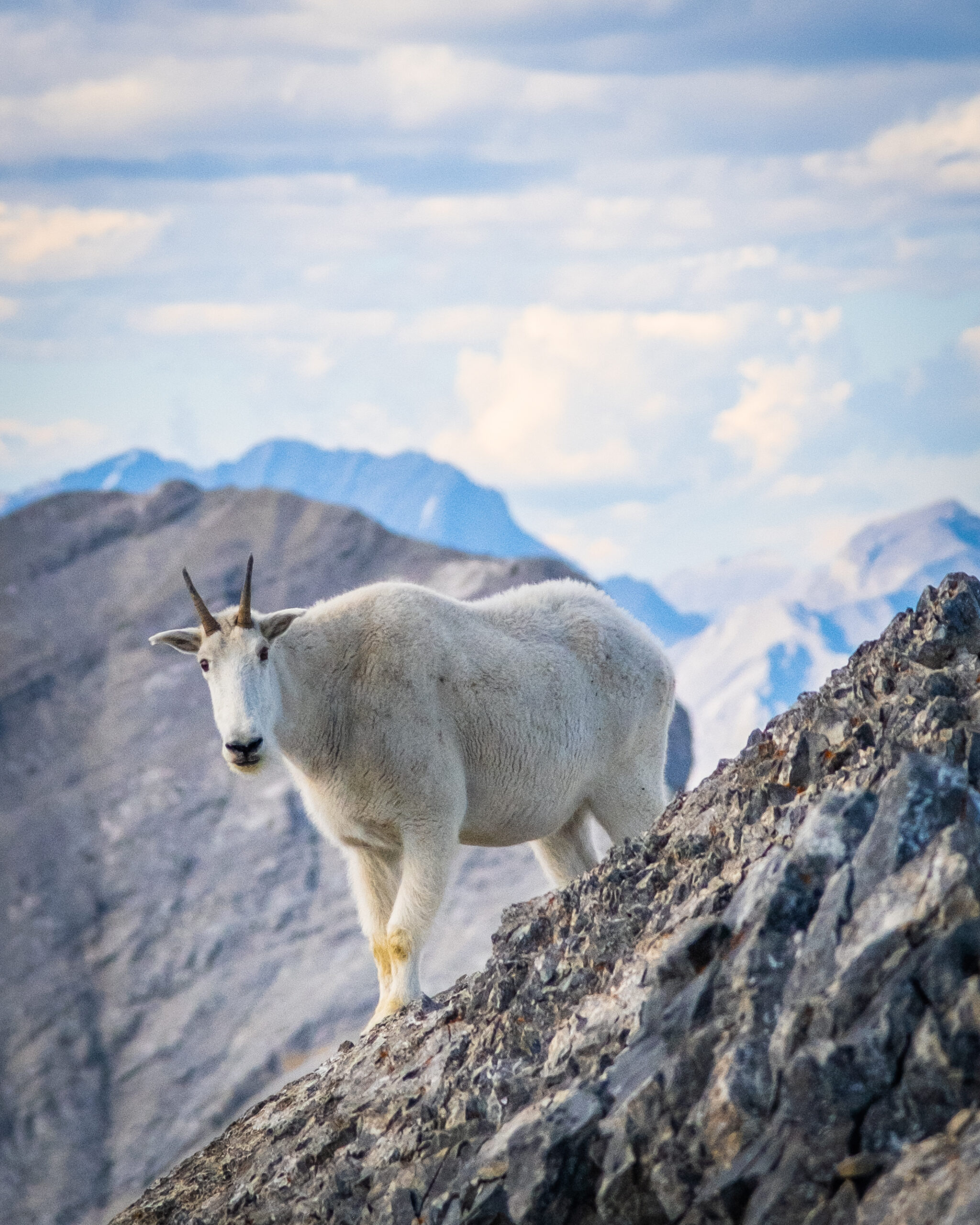
These master climbers will scale the steepest slopes with impressive speed and agility, and in hooved feet! More elusive than their curved-horned cousins, mountain goats feature shaggy white coats, beards, and short black horns. There is no better way to learn about the differences between bighorn sheep and mountain goats than by watching this lyrically educational video from Parks Canada.
Where Might I See Mountain Goats?
Mountain goats spend most of their time at high elevations (above 2000m), so catching a glimpse of one is very special. Look for vegetated areas near steep rock faces. You may get lucky on hikes like Cascade Mountain (pictured above), Mount Bourgeau, the Alpine Circuit at Lake O’Hara, or the Iceline Trail in Yoho National Park.
Salt and mineral deposits occasionally lure mountain goats from their lofty ledges. If driving the Icefields Parkway, check out one such hot spot, the Goats and Glaciers viewpoint north of Sunwapta Falls.
Beaver
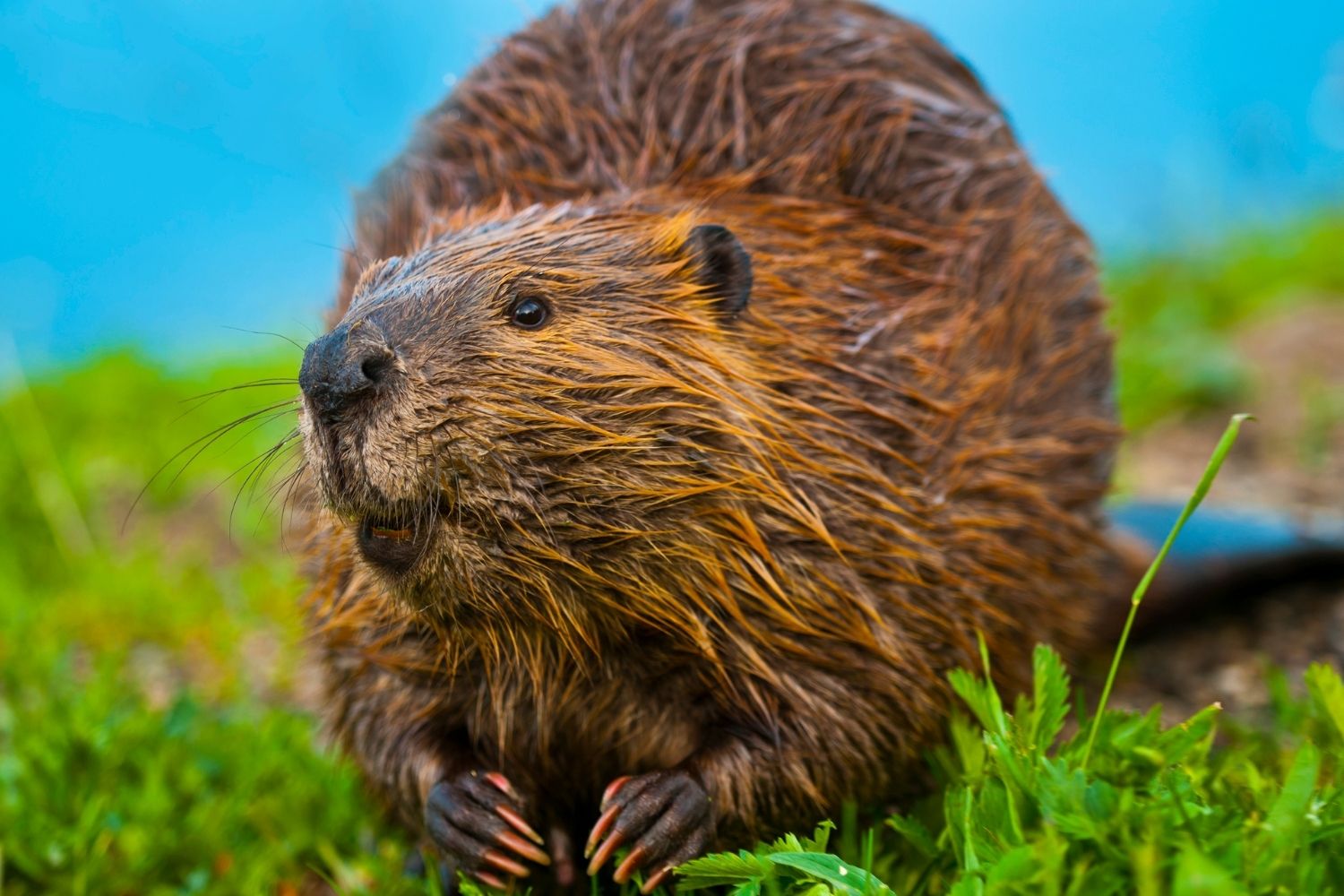
Canada’s national animal and engineers of nature, the emblematic beaver, has helped shape many river systems through extensive dam construction. You’ll find a few of their projects in Banff, including one along the Legacy Trail.
Beavers are not only exceedingly industrious, but also highly family-oriented. They mate for life and help their offspring construct their own dams when they finally set out on their own. Once trapped to near extinction for their luscious pelts, beaver populations have stabilized, with several families residing throughout the valley waterways.
Rest assured that no beavers are harmed in the making of the popular Canadian treat, ‘beavertails.’ These delicious deep-fried pastries simply pay homage to the beaver’s uniquely shaped tail. Those with a sweet tooth should check out the restaurant on Banff Ave or on Main Street in Canmore.
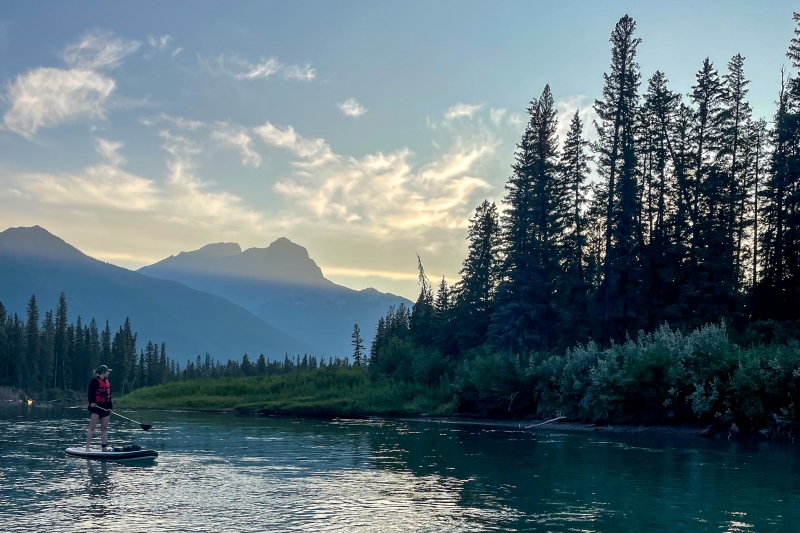
Where Might I See Beavers?
Take to the waters if you’re hoping to see a beaver as they spend most of their time in rivers, ponds or small lakes. Even so, beavers are notoriously shy, and sightings are fleeting. If you are fortunate enough to spot one cruising the surface of the water, it will likely slap it’s tail in alarm and dive below for safety.
A few beaver families live in Banff at Johnson Lake and along the Bow River, but you might have more luck with sightings in Jasper National Park, specifically at Cottonwood Slough on the way to Pyramid Lake or when hiking the Valley of the Five Lakes.
Moose
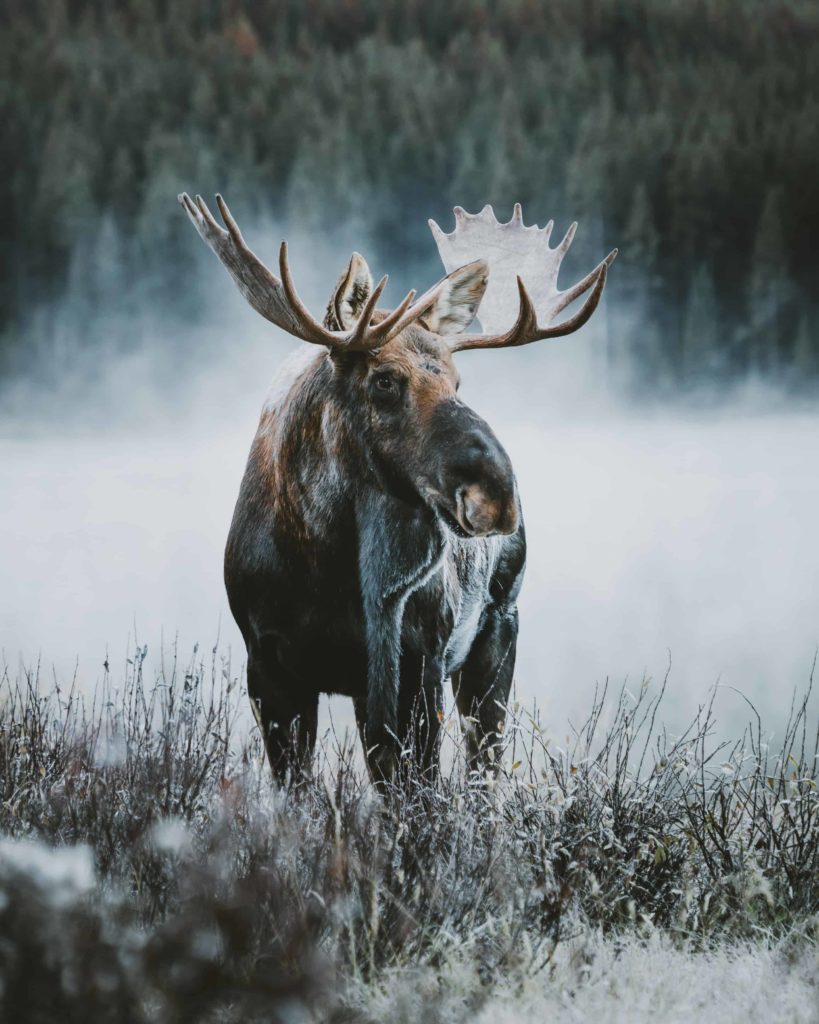
Another Canadian classic, moose are one of the largest creatures to walk the Rockies, distinguishable by their impressive size and horse-like appearance. Males sport wide antlers, which they shed in the winter and regrow in the spring to attract a mate and ward off competitors. Unlike elk, moose generally live solitary lives.
Where Might I See Moose?
Moose spend most of their time grazing, particularly around marshy areas. In Banff, they may make the occasional appearance around Waterfowl Lakes and the Saskatchewan Crossing. Kananaskis has a larger moose population with regulars who sometimes pass by the meadows by Mount Engadine Lodge.
That being said, we know that many visitors to the Canadian Rockies want to see a moose, but the reality is we almost never see them and consider ourselves lucky if we catch one once or twice a year! Remember not to get too close, moose are among some of the most dangerous creatures in the woodlands.
Hoary Marmot
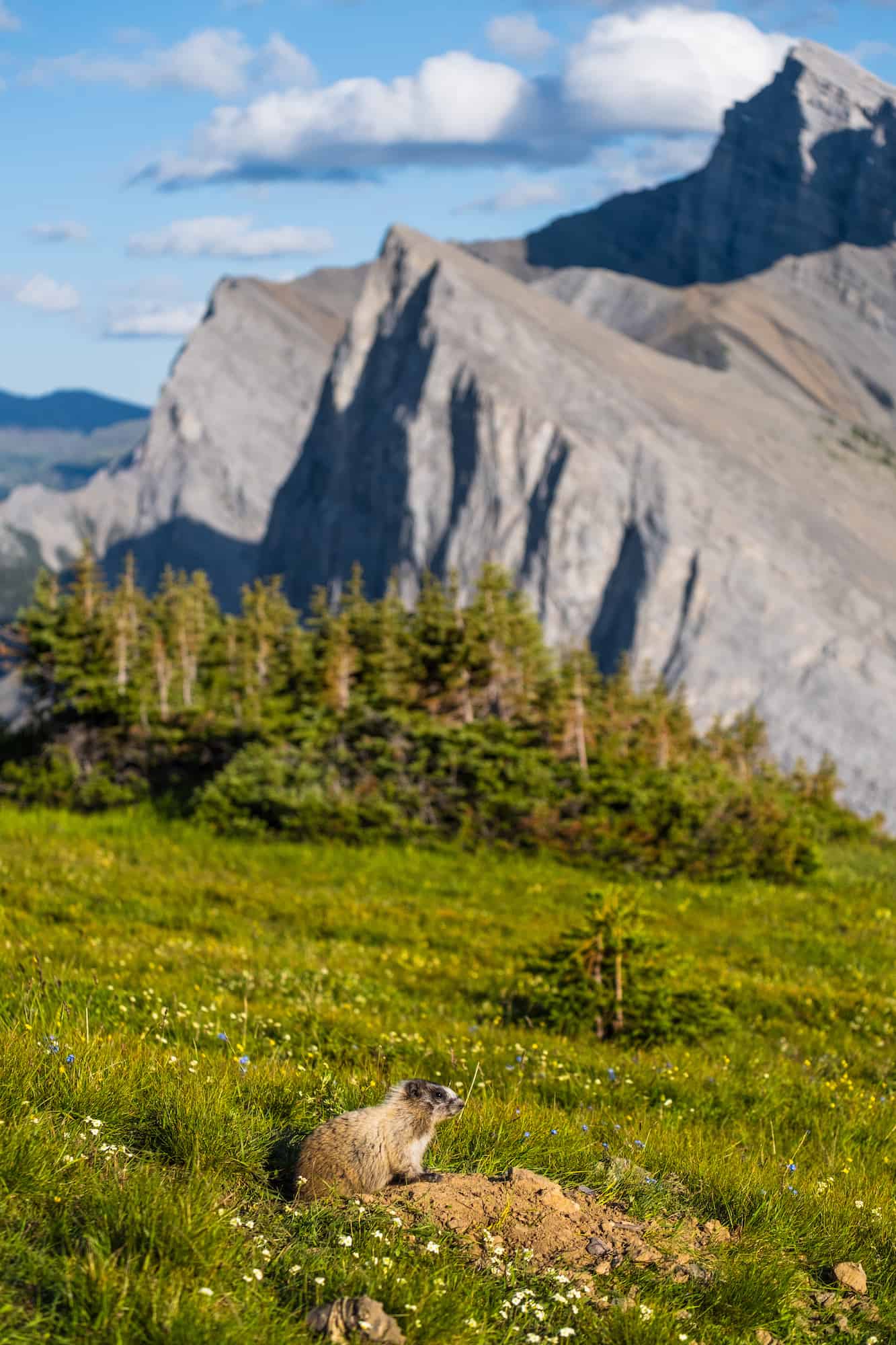
Fans of elevated living marmots are colonial rodents about the size of a cat that can often be spotted on hikes in alpine meadows. If you hear a loud whistling sound above the tree line, it could very well be an alarmed marmot warning their companions of approaching hikers. These high pitched calls have earned marmots the nickname ‘whistle pig’.
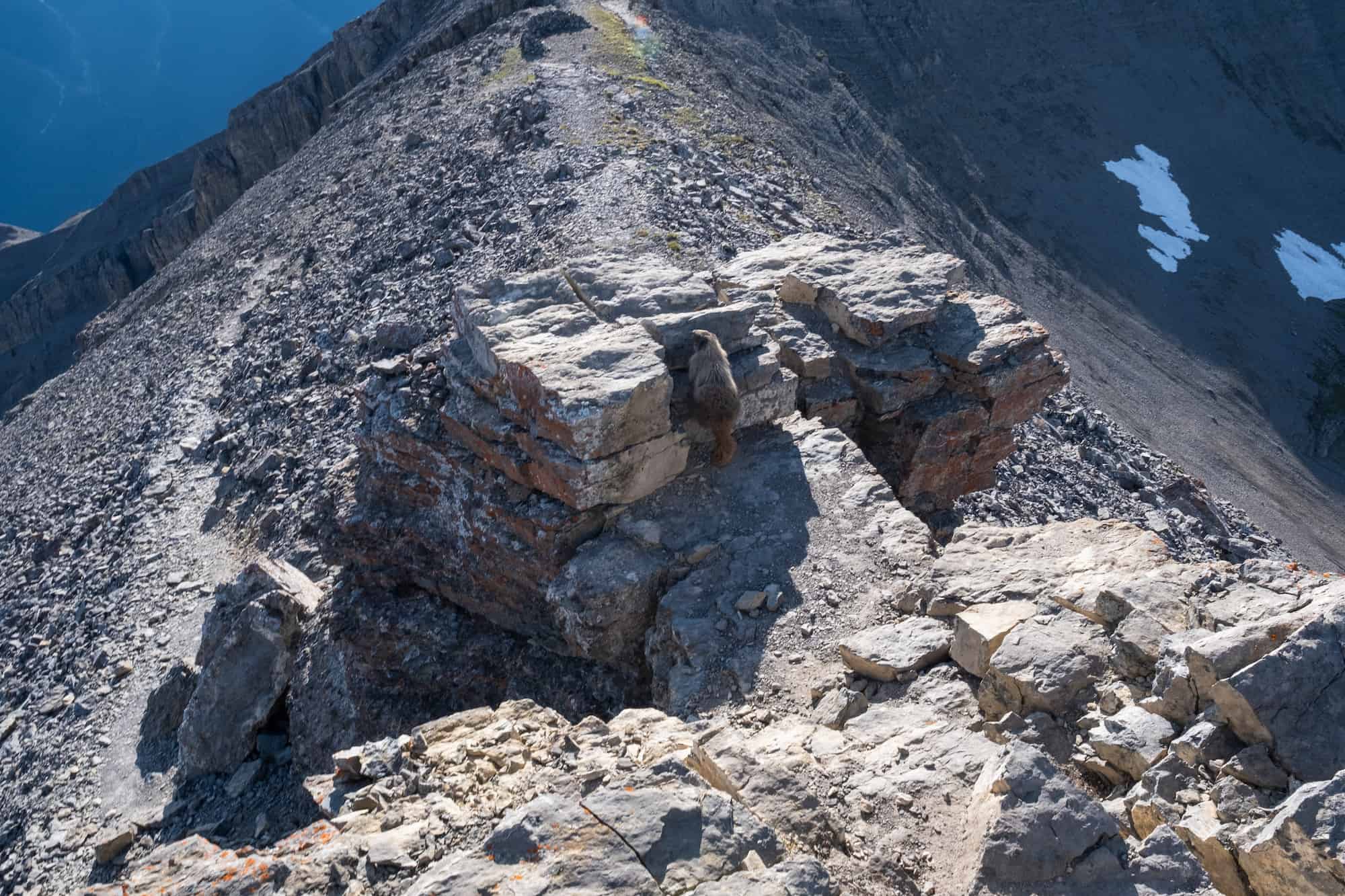
Where Might I See Marmots?
Marmots are featured on many popular Banff hikes that extend above the tree line, such as the Plain of Six Glaciers at Lake Louise, C-Level Cirque, and the Cascade Amphitheater on the way up Cascade Mountain. You can also spot marmots without a strenuous ascent, as they often scurry around the slopes at the top of the Banff Gondola and Jasper Skytram.
Pika
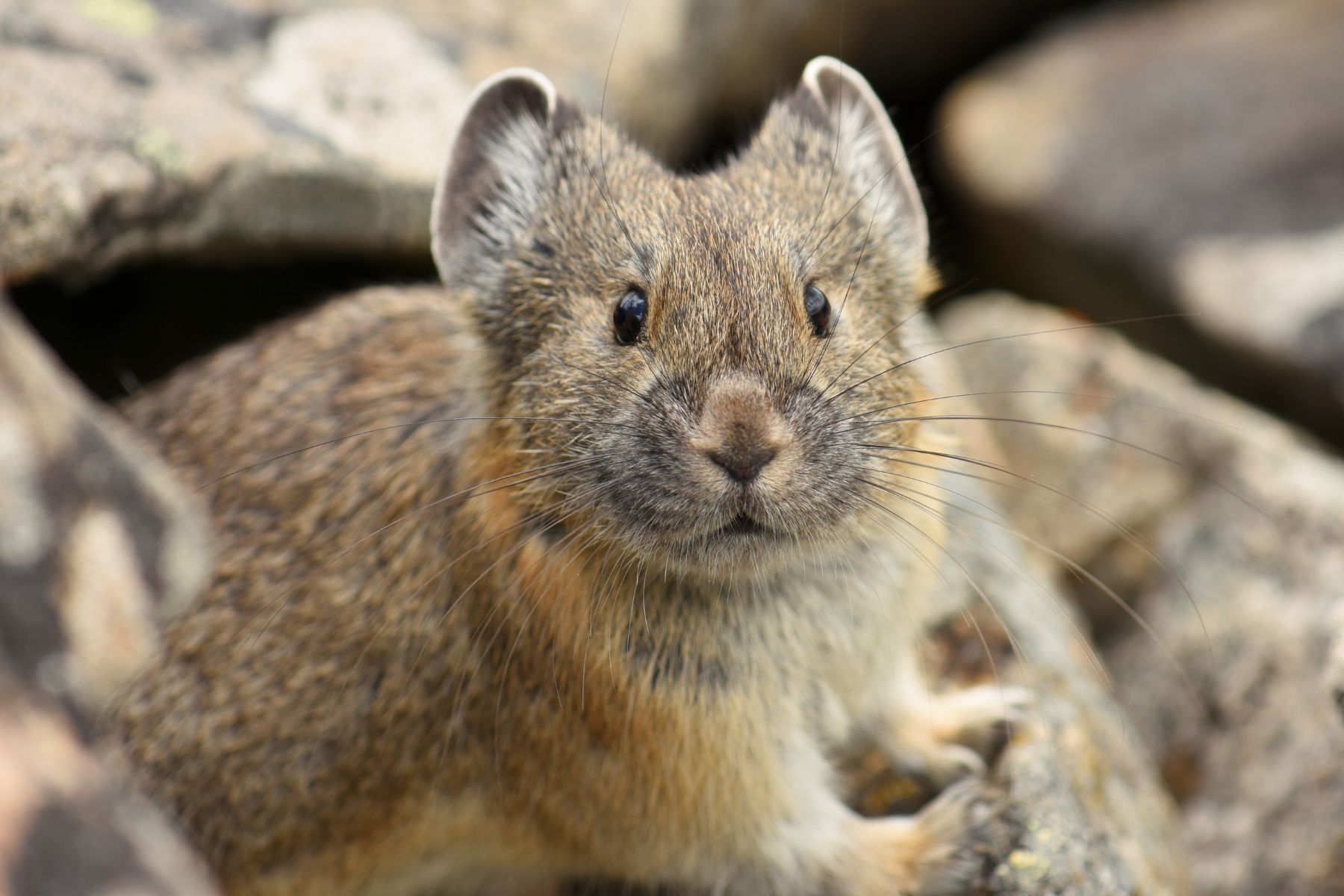
Much like marmots, pikas enjoy the higher elevations, scurrying around rockpiles and moraines in the alpine. These adorable ‘rock rabbits’ are some of the smallest animals in the Rockies, but also some of the loudest. A pika’s high-pitched ‘eeep’ serves as an alarm call and indication you’re sharing the trails. If you catch a glimpse of one, it is most likely gathering vegetation to store for the long winter months.
Where Might I See Pikas?
When hiking at elevations above 1800m, keep an eye out for small mouse-like creatures darting around on rockslides. They are often seen on the trails around Lake O’Hara, the far end of Lake Louise, and Moraine Lake.
Porcupine
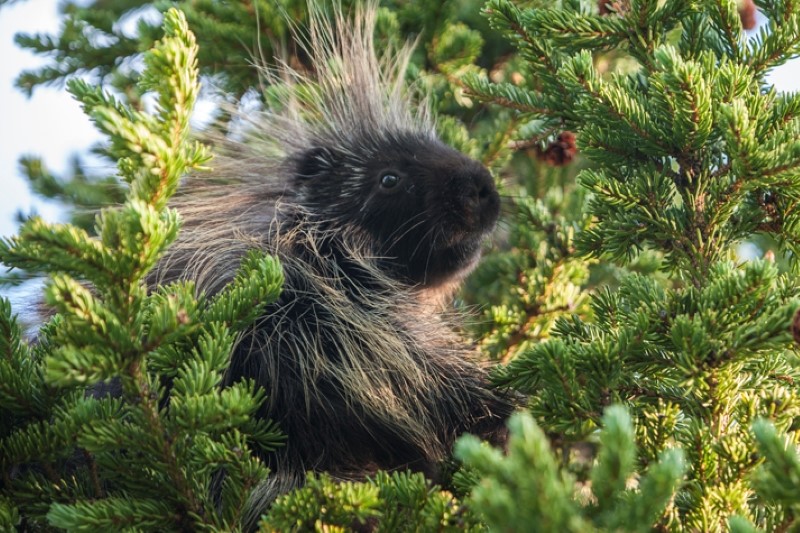
Despite their prickly exterior, porcupines are fairly docile, dedicating most of their time to foraging. Contrary to common myths, porcupines cannot shoot their sharp quills, but they will easily dislodge if any predators or off-leash dogs come in contact – a highly painful reminder to stay away.
Porcupines will often wander into backcountry campgrounds in the hopes of licking salty residue off hiking poles and other camp gear. They are particularly notorious on the Skoki Loop near Lake Louise as well as the Bugaboos, having destroyed many hiking boots and poles left outside tents. Otherwise, keep an eye to the trees, as porcupines sometimes scramble up to snack on bark.
Red Fox
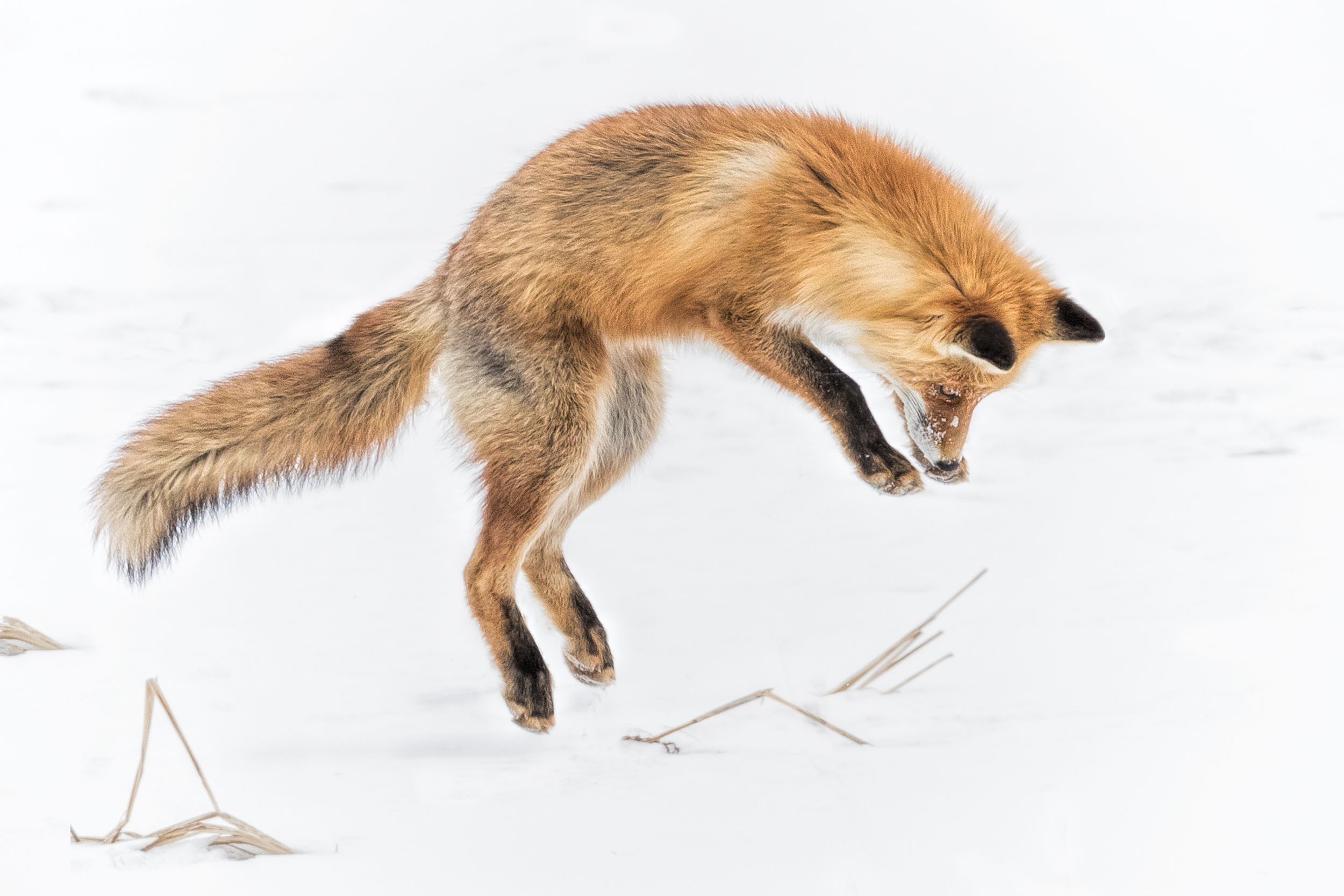
Red-coated and bushy-tailed, foxes are the smallest canines in the Rockies and one of the most commonly sighted carnivores. Foxes have adapted to human presence and become highly opportunistic, so you may catch a glimpse of one around roads, campgrounds, or day use areas. We’ve seen them a few times around Johnston Canyon and Tunnel Mountain.
Although both resembling and distantly related to man’s best friend, foxes should always be treated as wild animals, not pets.
Coyote

Similarly to scrappy dogs, coyotes are distinguished by their medium size and tawny-grey coats. They often patrol roads and highways to scavenge food. Coyotes are too bold for their own good and have very little fear of humans, which has led to a number of incidents.
More Elusive Mammals

- Wolves: These pack animals live in more remote areas of the parks. You can see their mixed-breed relatives, known as wolfdogs, by visiting the Yamnuska Wolfdog Sanctuary.
- Cougars: The formidable mountain lions are highly adept at remaining out of sight, although often noted on wildlife cameras. To marvel at this powerful apex predator (with safety assured!), visit the Calgary Zoo.
- Lynx: Another solitary cat, the nocturnal lynx rely on isolated areas with deep snow to successfully hunt and are unlikely to be seen by visitors.
- Wolverines: Incredibly shy and solitary, the few remaining wolverines keep to the rugged backcountry and high mountains.
Birds
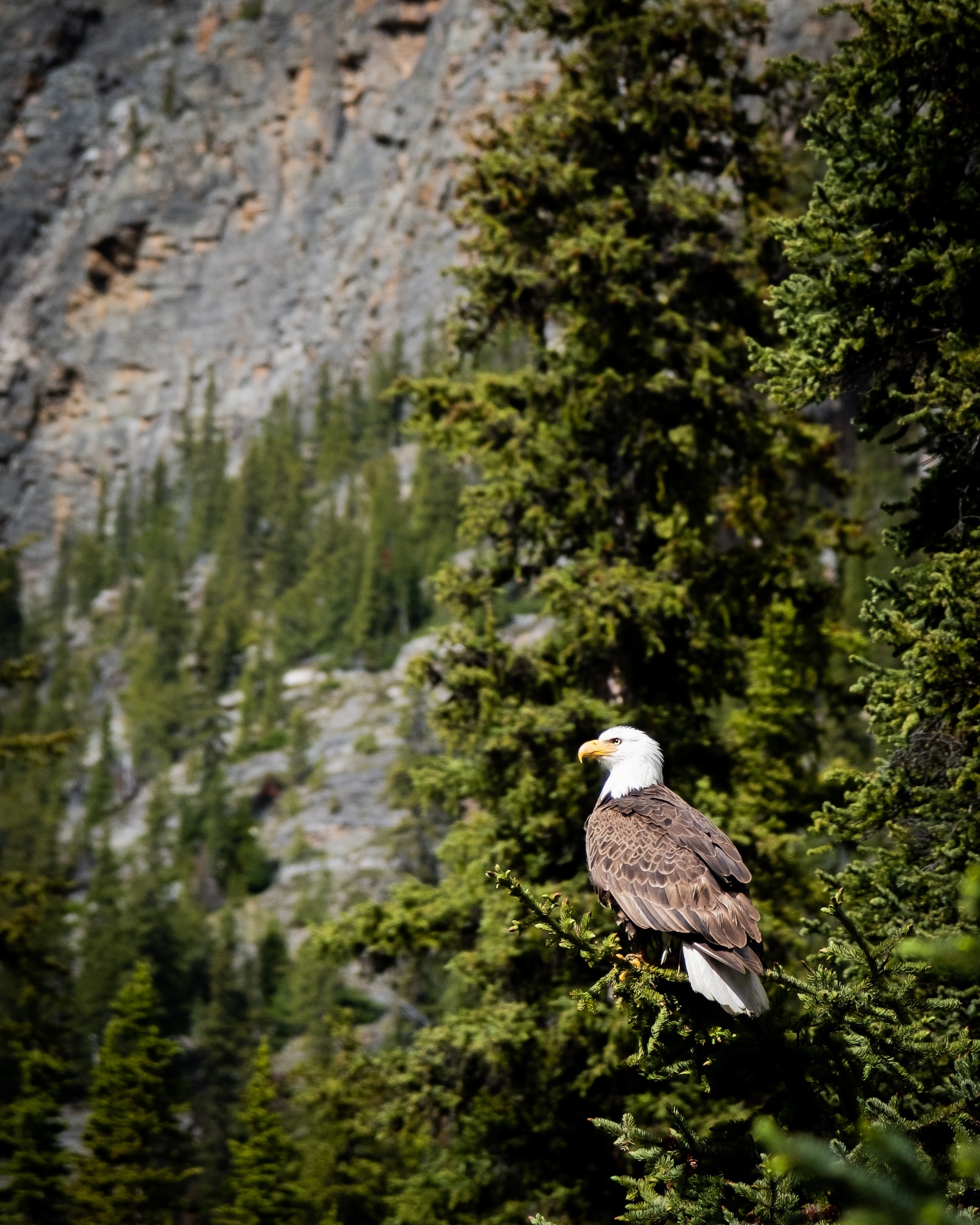
Hundreds of species of birds add song and flair to the Rockies. Some of the most notable species include bald eagles, osprey, grouse, ptarmigan, Canada geese, Clark’s nutcracker, in addition to various ducks and songbirds. Parks Canada has prepared a guide to birding in Banff with recommended locations and seasons. You can also stop by Banff National Park’s Visitor Centre for a full checklist of the birds found in the park.
Fish
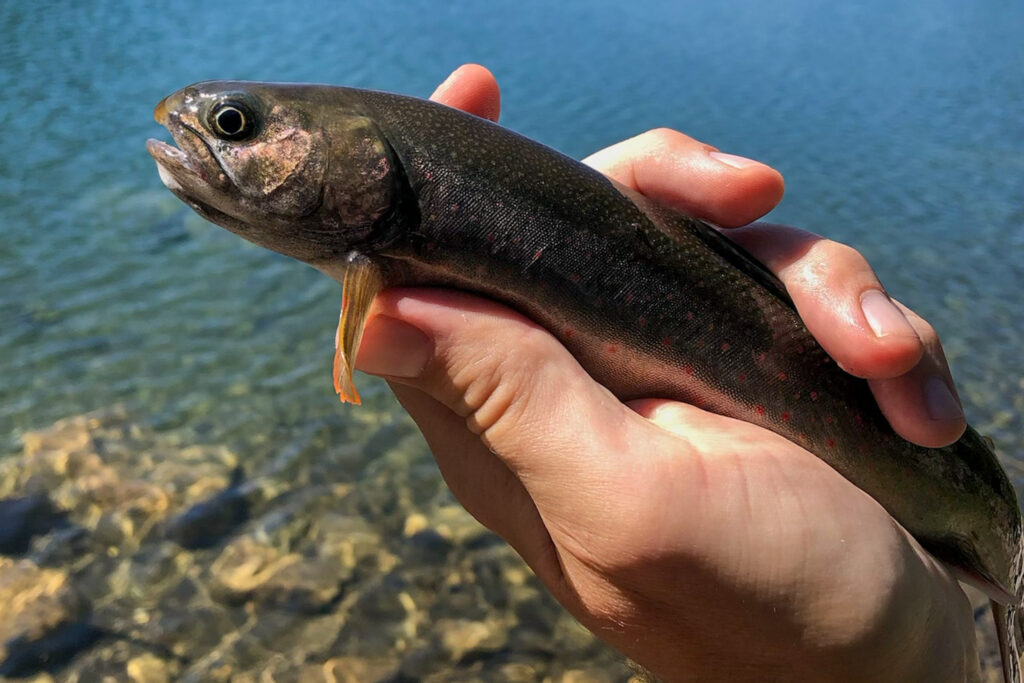
Most mountain lakes in the Rockies did not actually contain fish until the 20th century when stocking programs introduced populations to support tourism and recreational fishing. Although stocking has ceased in the national parks, fish continue to enjoy the frigid waterways. Trout are the most sought-after species for anglers, with Westslope Cutthroat Trout, Bull Trout and Athabasca Rainbow Trout being native to the mountains in Alberta.
Anglers would be hard pressed to find more tranquil and scenic locations to throw in a line, but Banff, Kananaskis, and other mountain parks like Yoho, Jasper and Waterton Lakes have strict regulations around fishing, with a significant emphasis on catch and release and other important conservation practices. Take some time to research before casting.
The clear waters of many mountain lakes also allows visitors to view fish from the shore – Chester Lake, Elbow Lake and Picklejar Lakes in Kananaskis are especially clear and fishy. In the winters, ice fishing is popular on Spray Lakes and Upper Kananaskis Lake.
Tips for Wildlife Spotting
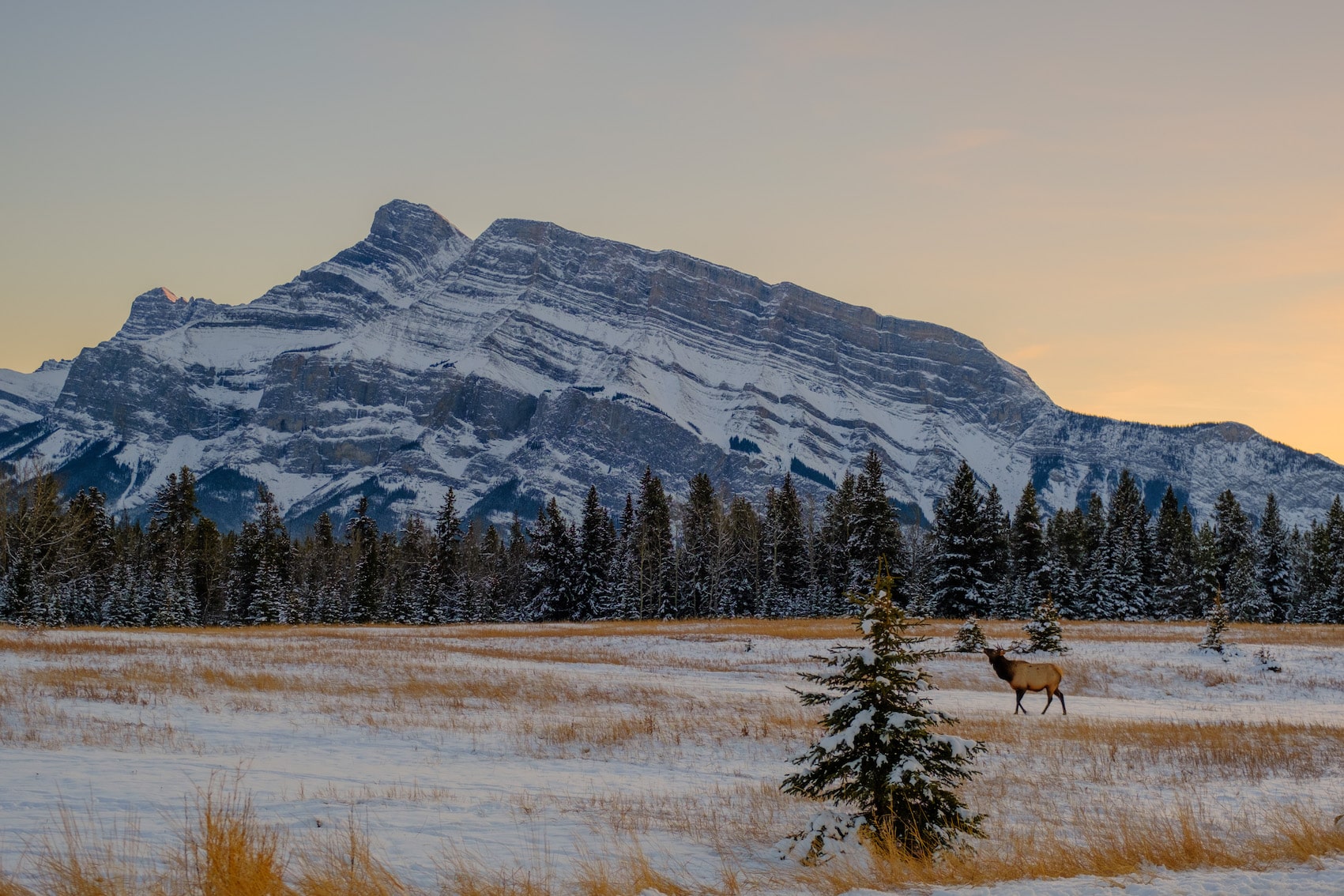
- Research wildlife behaviour and habitats. If you are keen to see a particular animal, you will increase your chances of an encounter by learning when and where they hang out.
- Get out at dawn or dusk. Most animals are active just after sunrise and before sunset. Fewer people travelling through the mountains at these times also means fewer potential disturbances. Conveniently, these are also the best time for photography!
- Plan for the season. While some animals are out and about all year, others sleep through the winter months or migrate between different habitats. Your chances of seeing bears are significantly lower when they’re all hibernating!
- Head to Jasper. Less crowded than Banff, Jasper offers more space and tranquility that helps wildlife thrive. Visitors to both parks often report more wildlife sightings in Jasper. More secluded areas of Kananaskis offer similar advantages.
- Book a wildlife tour. A number of operators in both Banff and Jasper offer wildlife safari-type tours with the specific purpose of viewing animals. Local guides have extensive knowledge of their wild neighbours and know some of the best places and times for observation.
Conserving our Wildlife
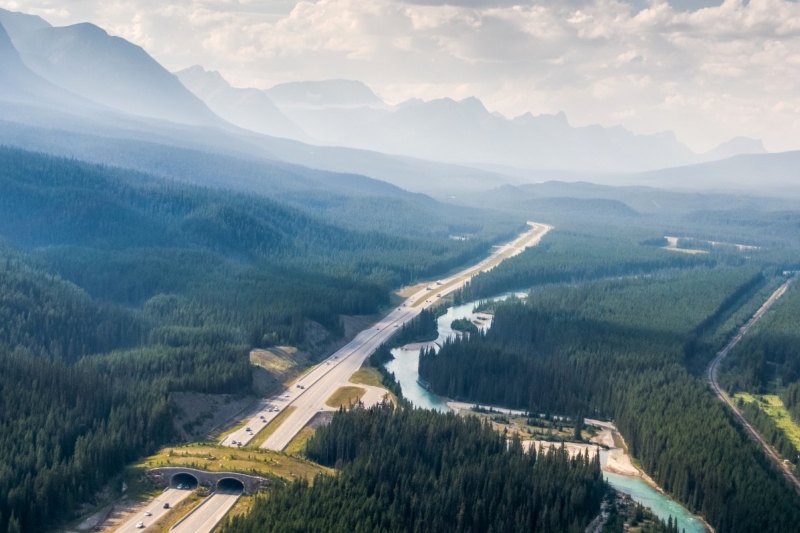
Canada’s mountain parks conserve and restore important ecosystems, protecting the spaces and habitats that are essential for different species to thrive. Many important infrastructure solutions and management practices have been introduced over the decades to support the wildlife that are so quintessential to the Rocky Mountains.
Banff’s wildlife crossings are one such feature that allows us to share the mountains with local animals. While they can be annoying to use, the latched waste bins also support human-animal coexistence. Most park rules are also in place for the benefit of our wild neighbours.
As a visitor, you can contribute to wildlife protection through park fees, educational activities, and by following rules and responsible practices like leaving no trace. Taking extra care and attention is well worth the effort and helps ensure that bears, beavers, and bighorn sheep will roam the Rockies for generations to come.
Plan Your Trip to the Canadian Rockies
- Recommended Experiences: There are many things to do in the Rockies, but our top recommendations include the Banff Gondola and a cruise on Maligne Lake to Spirit Island in Jasper. If you want a stress-free way to get to Moraine Lake, we highly recommend looking into Moraine Lake Bus Company.
- Hotels in the Rockies: There are many places to stay, from luxury hotels to wilderness cabins. See all our favorites here.
- Get to Banff or Canmore Without a Car: The Banff Airporter provides fantastic service connecting you from the Calgary International Airport (YYC) to Banff or Canmore.
- Get Around: We suggest renting a car to get around. You can search for rental cars on Rentalcars.com. For a campervan trip, you can check prices and compare on Outdoorsy.
- Cheaper Airfare: We also use Going for airfare deals and travel credit cards to earn points on purchases. Those credit card points can be redeemed for free flights and hotels! Our favorite cards is the Capital One Venture X (which has an insane welcome bonus right now) as it has no foreign transaction fees.
- Hop On, Hop Off: This tour is taking Banff by storm. It’s exactly what it sounds like, hop on and off a bus to visit all the best attractions at your own pace!

